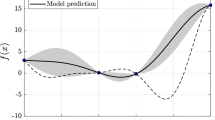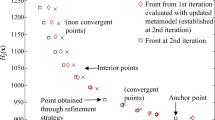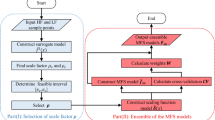Abstract
CoKriging is a popular surrogate modeling approach to approximate the input–output relationship using multi-fidelity data from different sources. However, it suffers from the big data issue due to its cubic time complexity and square memory complexity with the data size. This becomes even exacerbated for iterative design optimization. To overcome this limitation, this paper presents a new data sparsification method for multi-fidelity surrogate-based optimization (MFSBO). It includes two key components: reduced design space and data filtering (RDS&DF), which alleviate the surrogate modeling complexity and time for improved efficiency while balancing between exploration and exploitation during optimization. RDS&DF is also combined with an expected improvement reduction (EIR)-based infill technique (Yang et al. in Struct Multidiscip Optim, 2022. https://doi.org/10.1007/s00158-022-03240-x), enabling both parsimony and computational awareness for MFSBO. Two case studies are conducted to examine the proposed method. Results demonstrate that a significant reduction in the modeling and thus optimization time (69.49% and 73.92%) is achieved while retaining the design accuracy.













Similar content being viewed by others
References
Forrester AIJ, Sóbester A, Keane AJ (2007) Multi-fidelity optimization via surrogate modelling. Proc R Soc A Math Phys Eng Sci 463:3251–3269. https://doi.org/10.1098/rspa.2007.1900
Yang H, Hong SH, ZhG R, Wang Y (2020) Surrogate-based optimization with adaptive sampling for microfluidic concentration gradient generator design. RSC Adv 10:13799–13814
Park C, Haftka RT, Kim NH (2017) Remarks on multi-fidelity surrogates. Struct Multidiscip Optim 55:1029–1050. https://doi.org/10.1007/s00158-016-1550-y
Kleijnen JPC (2017) Design and analysis of simulation experiments: tutorial. Adv Model Simul 2017:135–158
Marques AN, Lam RR, Chaudhuri A et al (2019) A multifidelity method for locating aeroelastic flutter boundaries. AIAA Scitech 2019 Forum. https://doi.org/10.2514/6.2019-0438
Fernández-Godino MG, Park C, Kim N-H, Haftka RT (2016) Review of multi-fidelity models. Preprint arXiv:16090.7196
Peherstorfer B, Willcox K, Gunzburger M (2018) Survey of multifidelity methods in uncertainty propagation, inference, and optimization. SIAM Rev 60:550–591. https://doi.org/10.1137/16M1082469
Liu H, Ong Y, Shen X, Cai J (2020) When Gaussian process meets big data: a review of scalable GPs. IEEE Trans Neural Netw Learn Syst. https://doi.org/10.1109/tnnls.2019.2957109
Lawrence N, Seeger M, Herbrich R (2003) Fast sparse Gaussian process methods: the informative vector machine. Adv Neural Inf Process Syst 1:1
Lee BJ, Lee J, Kim KE (2017) Hierarchically-partitioned Gaussian process approximation. In: Proceedings of the 20th international conference on artificial intelligence and statistics, AISTATS 2017 54
Hensman J, Fusi N, Lawrence ND (2013) Gaussian processes for big data. Preprint arXiv:1309.6835
Snelson E, Ghahramani Z (2007) Local and global sparse Gaussian process approximations. J Mach Learn Res 2:524–531
Kleijnen JPC, van Beers WCM (2020) Prediction for big data through Kriging: small sequential and one-shot designs. Am J Math Manag Sci 39:199–213. https://doi.org/10.1080/01966324.2020.1716281
Chalupka K, Williams CKI, Murray I (2013) A framework for evaluating approximation methods for Gaussian process regression. J Mach Learn Res 14:333–350
Das S, Roy S, Sambasivan R (2018) Fast Gaussian process regression for big data. Big Data Res 14:12–26. https://doi.org/10.1016/j.bdr.2018.06.002
Melkumyan A, Ramos FT (2009) A sparse covariance function for exact Gaussian process inference in large datasets. In: 21st international joint conference on artificial intelligence
Wilson A, Nickisch H (2015) Kernel interpolation for scalable structured Gaussian processes (KISS-GP). In: International conference on machine learning. PMLR, pp 1775–1784
Rullière D, Durrande N, Bachoc F, Chevalier C (2018) Nested Kriging predictions for datasets with a large number of observations. Stat Comput 28:849–867
Gramacy RB (2016) LaGP: large-scale spatial modeling via local approximate Gaussian processes in R. J Stat Softw. https://doi.org/10.18637/jss.v072.i01
Wang H, Emmerich M, Van Stein B, Back T (2017) Time complexity reduction in efficient global optimization using cluster Kriging. In: GECCO 2017—proceedings of the 2017 genetic and evolutionary computation conference 889–896. https://doi.org/10.1145/3071178.3071321
Yang H, Hong SH, Wang Y (2022) A sequential multi-fidelity surrogate-based optimization methodology based on expected improvement reduction. Struct Multidiscip Optim. https://doi.org/10.1007/s00158-022-03240-x
Yang H, Hong SH, Wang Y (2022) A novel adaptive sampling method based on expected improvement reduction. In: Conference proceedings—IEEE SOUTHEASTCON
Shi R, Liu L, Long T et al (2018) Dual-sampling based co-kriging method for design optimization problems with multi-fidelity models. Multidiscip Anal Optim Conf 2018:1–14. https://doi.org/10.2514/6.2018-3747
Forrester AIJ, Sóbester A, Keane AJ (2008) Engineering design via surrogate modelling. Wiley, New York
Laguna M, Marti R (2005) Experimental testing of advanced scatter search designs for global optimization of multimodal functions. J Global Optim 33:235–255
Irimia D, Geba DA, Toner M (2006) Universal microfluidic gradient generator. Anal Chem 78:3472–3477. https://doi.org/10.1021/ac0518710
Cabaleiro JM (2020) Flowrate independent 3D printed microfluidic concentration gradient generator. Chem Eng J 382:122742
Yang CG, Wu YF, Xu ZR, Wang JH (2011) A radial microfluidic concentration gradient generator with high-density channels for cell apoptosis assay. Lab Chip 11:3305–3312. https://doi.org/10.1039/c1lc20123a
Wang X, Liu Z, Pang Y (2017) Concentration gradient generation methods based on microfluidic systems. RSC Adv 7:29966–29984. https://doi.org/10.1039/c7ra04494a
Hong SH, Yang H, Wang Y (2020) Inverse design of microfluidic concentration gradient generator using deep learning and physics-based component model. Microfluid Nanofluidics 24:1
Wang Y, Mukherjee T, Lin Q (2006) Systematic modeling of microfluidic concentration gradient generators. J Micromech Microeng 16:2128–2137. https://doi.org/10.1088/0960-1317/16/10/029
Zhou Y, Wang Y, Mukherjee T, Lin Q (2009) Generation of complex concentration profiles by partial diffusive mixing in multi-stream laminar flow. Lab Chip 9:1439–1448. https://doi.org/10.1039/b818485b
Acknowledgements
YW acknowledges the faculty startup grant from the University of South Carolina for partial funding of this research.
Author information
Authors and Affiliations
Corresponding author
Ethics declarations
Conflict of interest
The authors declare that they have no conflict of interest.
Data availability
All data and codes are available from the author upon reasonable request.
Additional information
Publisher's Note
Springer Nature remains neutral with regard to jurisdictional claims in published maps and institutional affiliations.
Rights and permissions
Springer Nature or its licensor (e.g. a society or other partner) holds exclusive rights to this article under a publishing agreement with the author(s) or other rightsholder(s); author self-archiving of the accepted manuscript version of this article is solely governed by the terms of such publishing agreement and applicable law.
About this article
Cite this article
Yang, H., Wang, Y. A sparse multi-fidelity surrogate-based optimization method with computational awareness. Engineering with Computers 39, 3473–3489 (2023). https://doi.org/10.1007/s00366-022-01766-8
Received:
Accepted:
Published:
Issue Date:
DOI: https://doi.org/10.1007/s00366-022-01766-8




